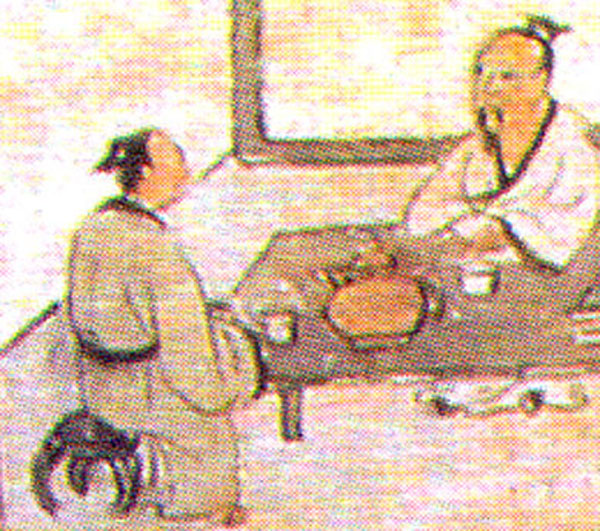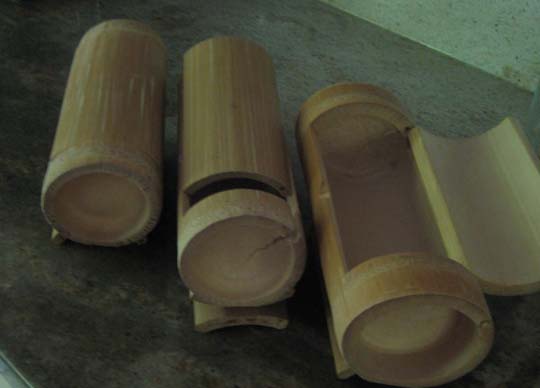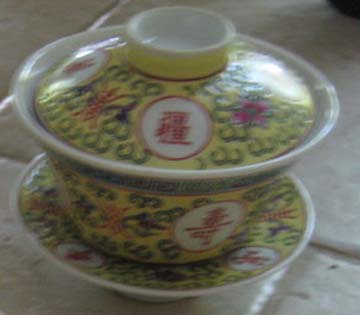
| What is Flavor and Fortune? |
| How do I subscribe? |
| How do I get past issues? |
| How do I advertise? |
| How do I contact the editor? |
Read 12949647 times
Connect me to:
| Home |
| Articles |
| Book reviews |
| Letters to the Editor |
| Newmans News and Notes |
| Recipes |
| Restaurant reviews |
| Article Index (all years, slow) |
| List of Article Years |
| Article Index (2025) |
| Article Index (last 2 years) |
| Things others say |
| Related Links |
| Log In... |
| Authors |
| Categories & Topics |
Tea Drinking by Chinese Minority Populations
| by Jacqueline M. Newman |
Beverages
Winter Volume: 2010 Issue: 17(4) page(s): 10, 11, and 14
 Yes, all fifty-five Chinese ethnic minorities drink and adore tea, but not all of them drink it as did the Han majority population during the Ming Dynasty nor the same ways the Han drink it now. Writing about these minorities could fill a book or two, if we could locate enough to share, but we can not. This article touches on twenty-one population groups. For some it will be just a sip of information, for others their cups will be more full; it is uneven verbal tastes about their tea drinking, all we could locate now.
Yes, all fifty-five Chinese ethnic minorities drink and adore tea, but not all of them drink it as did the Han majority population during the Ming Dynasty nor the same ways the Han drink it now. Writing about these minorities could fill a book or two, if we could locate enough to share, but we can not. This article touches on twenty-one population groups. For some it will be just a sip of information, for others their cups will be more full; it is uneven verbal tastes about their tea drinking, all we could locate now.
For example, in the Zhejiang Province, there are many tea trees and many minority populations. In the Huzhou Prefecture, people welcome guests and show off their many tea sets. They serve tea with fruits and condiments, pour water over their tea leaves, and sometimes use tea cups of bamboo. They pour hot water into these cups very slowly, and sip their tea very slowly, too.
Many ethnic minority populations add pickled salty green soybeans into their tea. When these are very aromatic, hostesses in their homes says: Drink tea, and everyone takes theirs in small bowls. After they do, a large bowl with no spout arrives filled with nuts and seeds to accompany this tea. Traditionally, they consume three cups of tea, and rarely drink more than three at one sitting.
In China's southwest, including the province of Yunnan, many minority populations live. Others live in lesser numbers all over China, more in some specific minority autonomous regions. These minorities have rich tea cultures, including those living in the Central Plains. There and everywhere, for them tea is a beverage, an herb, and a vegetable, its leaves cooked with many other foods.
Roasting tea became popular during the Tang Dynasty (618 - 907 CE) when many minorities learned to roast their tea leaves in a wok or pan, in bamboo, or in another container. Of course, not all ethnic minority populations roast their tea. Some drink it plain, others with other ingredients in it or with it. Not all of these people simply use the tea leaves to brew tea nor do all cook with their tea leaves. Some save their leftover leaves and scatter them in the corners of their rooms to absorb moisture, others stuff them into pillow cases and sleep on them.
Many minorities do these and other things, as discussed below, presented in alphabetic order so as to not to give any one of them preference over another. Also, be aware there is not tea consumption information about all ethnic minority populations, but only for those for which we have located material.
BAI ethnic populations are a minority group that loves roasted tea. They make a three-course roasted tea in porcelain pots roasting yellow teas, for the most part. When these leaves turn brown, then they pour boiling water over them, often add sugar and rice flowers, and then enjoy their tea with walnuts, honey, and ginger mixed into it. They call their three course tea-drinking ceremony san dao. Another way they like to take tea is to put baked tea leaves into a pot and put that pot over charcoal, and fill it with boiling water there. When brewed, they pass the tea pot around once for everyone to smell the tea. The second and third times it is passed, tea is poured into everyone’s cups and they drink this tea; hence their three-course tea. On ordinary days, the Bai drink tea twice, morning and at noon. The first is called 'wakening tea' and the second called 'relaxing tea.' This second tea might have popcorn or milk added to it. They also roast tea in bamboo tubes, and say that its first taste is called 'bitter tea.' After that cup they add sugar, often brown slab sugar, along with smashed sesame seeds or smashed walnuts. For this second cup, called 'after taste tea' they can add honey, toasted pieces of dried cheese, pieces of cinnamon bark, even toasted Sichuan peppercorns. Bai people say their tea is bitter, sweet, sour, salty, and pungent, but not all at any one time. However, at almost every tea-drinking occasion when consuming their ceremonial san dao or three course special tea, then it usually is.
 BLANG minority folk like large tea leaves to make their tea. They pack these leaves tightly into bamboo tubes and seal them. Some even bury these tubes for months, even years. When they dig them up, they brew the leaves or cook and eat them as a sour vegetable. There are times they simply eat the tea leaves at room temperature, just dug out of these bamboo tubes.
BLANG minority folk like large tea leaves to make their tea. They pack these leaves tightly into bamboo tubes and seal them. Some even bury these tubes for months, even years. When they dig them up, they brew the leaves or cook and eat them as a sour vegetable. There are times they simply eat the tea leaves at room temperature, just dug out of these bamboo tubes.
BOUYEI people love their tea green without additions. They and almost all ethnic minority peoples, like the Han Chinese, hand their teacups to those they are serving tea using two hands. To do otherwise is considered rude.
DAI minority folk most often roast their tea leaves in sections of bamboo, and do so over a low fire. Then they split the bamboo tube open and use it to make tea. Some Dai people pour boiling water over these tubes then drink the tea from the tube. It is most common for the oldest man in the group to serve guests this tea, which they call 'bamboo tea.'
DONG people stir-fry their dried tea leaves with rice. They put this into their teapots with the rice which is popped when stir-fried, along with soybeans, slices of pig liver, peanuts, and tiny dumplings. These dumplings use wrappers made with ground glutinous rice. The Dong also drink 'oil tea' which is made with tea leaves fried in oil; it id then brewed.
DULONG people brew plain and/or roasted tea leaves. They like to use some tea leaves as vegetables, and adore putting some of these leaves into stewed dishes.
GAOSHAN ethnic populations prefer their tea prepared, that is brewed, with the skins of mandarin oranges. Obviously, they call this 'mandarin tea.'
HANI ethnic peoples use mature large tea leaves and roast them in the fire in bamboo containers. They then cool the leaves before brewing them in iron pots. They like their tea made mixing oolong and black tea, or they drink one or the other kind.
 HUI people are almost all Muslim. They drink a tea they call san po tai. This is not tea made in three parts, but tea made in a cup that has three parts. Their three-part tea cup is a cup a bit wider and larger than most, a saucer beneath it, and a cover used on the top of the cup which acts like a strainer. In season, they add three fresh longan fruits, their skins left on. These are put into the cup first, then the tea leaves go on top of them, and boiling water is added to this. Out of season they use dried longan fruit, longan paste will do, too. Boiling water is re-poured over these items as often as desired or as needed, the cups refilled many times. The tea served to us in one home was green, in another it was oolong. In that Hui home, we learned to drink tea holding the cover at an angle using it as a strainer to keep leaves in cup and out of mouth. We also learned that when one starts to eat the fruit, you are telling your host not to serve you more tea.
HUI people are almost all Muslim. They drink a tea they call san po tai. This is not tea made in three parts, but tea made in a cup that has three parts. Their three-part tea cup is a cup a bit wider and larger than most, a saucer beneath it, and a cover used on the top of the cup which acts like a strainer. In season, they add three fresh longan fruits, their skins left on. These are put into the cup first, then the tea leaves go on top of them, and boiling water is added to this. Out of season they use dried longan fruit, longan paste will do, too. Boiling water is re-poured over these items as often as desired or as needed, the cups refilled many times. The tea served to us in one home was green, in another it was oolong. In that Hui home, we learned to drink tea holding the cover at an angle using it as a strainer to keep leaves in cup and out of mouth. We also learned that when one starts to eat the fruit, you are telling your host not to serve you more tea.
JINGPO ethnic minority populations pickle their tea leaves. After some days in a pickling liquid, they take them out and dry them, usually in the sun. Then they brew their tea using these pickled leaves.
JUNO minorities drink tea made strong with lots of tea leaves. They also use tea leaves and liquid tea in some of their cold dishes, and in many of thier sauces are cooked with them. The Juno also knead crumpled or crushed tea leaves mixed with fruit juices, sour bamboo shoots, chili peppers, salt, and sour preserved ants before adding hot water and making this mixture into their tea.
KOREAN-Chinese ethnic populations prefer to drink ginseng tea or black tea. They have these many times in a day, ten or more times is typical.
MIAO, also known as Hmong, particularly in the United States and other English-speaking countries, like their tea leaves roasted; and they like what they call ba bao oil tea made frying their tea leaves with or without ginseng.
MONGOL peoples drink their tea with milk and salt. They boil water for it early in the morning, break pieces of brick tea into their teapot, add salt and butter, and some milk skin along with lots of milk when making their tea. They keep this brewed tea on low heat all day long, and pour some for themselves many times during the day.
NAXI populations drink their tea mixed with salt, and they like to drink oolong tea most often. They serve it with many condiments, nuts and fried dough are most poular.
RUSSIAN-Chinese ethnic populations drink their tea after it is brewed in a samovar. They prefer black tea such as qimen, earlier spelled keemun, and they like a particular black tea called Russian Caravan Tea. These they often drink from a glass, and they put a cube of sugar between their teeth when doing so.
TIBETANS get lot of nourishment from their tea. They add butter, dried cheese, milk, and tsampa which is roasted barley flour. The milk and the dried cheese might be from a cow, but more often it is from a yak. They add salt or should someone in the family not be allowed to have salt in their tea, they serve it with a salt shaker for those who can. Some Tibetans add crushed walnuts, sesame seeds, peanuts, and/or pine nuts, then beat these with their tea in a tall wooden churn. When ready to serve, they put it into a pot with a long spout, some two feet in length, and proudly pour it from on high not spilling a single drop. This ethnic population can drink tea all day long. When first in a Tibetan home, a guest is presented with a long blue or white scarf, and then served tea. This is a sign of their hospitality. Once, after our tea, we were given huge ox bones to chew on; another honor. On that occasion, when ready to quit drinking tea, we left our cups full and knew not to drink another drop. To do otherwise means the host or hostess needs to keeps teacups full. It is interesting to note that Tibetans began to drink tea about 700 CE after Princess Wenchang went there to marry Songzan Gambo. They exchanged horses for tea, said that cheese put in to tea and served with meat helps them digest it. When the envoy Duke Changsu went to Tibet, he returned saying they believe their tea removes worry and thirst. A recipe for Tibetan tea is in Flavor and Fortune’s Volume 2(4).
TUJIA minorities grind their newly pickled and dried tea leaves with ginger and rice before adding boiling water. They like green, oolong, and black teas at different times of the day, and different folks drink one or another of them then.
UYGUR ethnic peoples, like the Russian Chinese, like their tea from in a glass, and they use cubes of sugar as do the Russian Chinese. They also like to mix the skin that forms on milk into their tea.
YI populations use dry-roasted tea leaves along with bamboo shoots, garlic, chilies, and salt in their tea.
ZHUANG people make their tea with the leaves of local plants and not always with tea leaves. To either, they add sugar before drinking either of these beverages.

Copyright © 1994-2025 by ISACC, all rights reserved
Address
3 Jefferson Ferry Drive
S. Setauket NY 11720